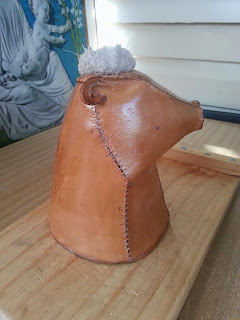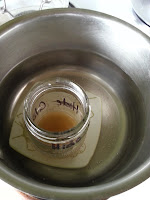Section one
Chapter XVI
"get a leaf of druggists' glue, not fish glue,"
Chapter XXXI
Section three
"Then, when you want to work, remember first to make this plaster quite uneven and fairly rough."
Section 5
"There is one size which is made of cooked batter, and it is good for parchment workers and masters who make books; and it is good for pasting parchments together, and also for fastening tin to parchment. We sometimes need it for pasting up parchments to make stencils. This size is made as follows. Take a pipkin almost full of clear water; get it quite hot. When it is about to boil, take some well-sifted flour; put it into the pipkin little by little, stirring constantly with a stick or a spoon. Let it boil, and do not get it too thick. Take it out; put it into a porringer. If you want to keep it from going bad, put in some salt; and so use it when you need it"
Section 5
How Goat Glue is Made, and How it is Tempered; And How many Purposes it will Serve.
Chapter CVIIII
"And there is a glue which is known as leaf glue; this is made out of clippings of goats' muzzles, feet, sinews, and many clippings of skins. This glue is made in March or January, during those strong frosts or winds; and it is boiled with clear water until it is reduced to less than a half.[102] Then put it into certain flat dishes, like jelly molds or basins, straining it thoroughly. Let it stand overnight. Then, in the morning, cut it with a knife into slices like bread; put it on a mat to dry in the wind, out of the sunlight; and an ideal glue will result. This glue is used by painters, by saddlers, and by ever so many masters, as I shall show you later on. And it is a good glue for wood, and for many things. We shall discuss it thoroughly, showing what it may be used for, and how, for gessos, for tempering colors, making lutes, tarsias, fastening pieces of wood and foliage ornament together, tempering gessos, doing raised gessos; and it is good for many things."
A Perfect Size for Tempering Gessos for Anconas or Panels.
Chapter CX
"And there is a size which is made of the necks[103] of goat and sheep parchments, and clippings of these parchments; these are washed [p. 67] thoroughly, and put to soak a day before you put them on to boil. Boil it with clear water until the three parts are reduced to one. And when you have no leaf glue, I want you just to use this size for gessoing panels or anconas; for you cannot get any better one anywhere."
A Size Which is Good for Tempering Blues and Other Colors.
Chapter CXI
"And there is a size which is made from the scrapings of goat or sheep parchment. Boil them with clear water until it is reduced to a third.[104] Know that it is a very clear[105] size, which looks like crystal. It is good for tempering dark blues. And apply a coat of this size in any place where you have happened to lay in colors which were not tempered sufficiently, and it will retemper the colors, and reinforce them, so that you may varnish them at will, if they are on panel; and blues on a wall the same way. And it would be good for tempering gessos, too; but it is lean in character, and it ought to be rather fat for any gesso which has to take gilding."
Section 5
To Make a Glue out of Lime and Cheese.
Chapter C XII
"Ends the Fifth[107] Section of This Book.
There is a glue used by workers in wood; this is made of cheese. After putting it to soak in water, work it over with a little quicklime, using a little board with both hands. Put it between the boards; it joins them and fastens them together well. And let this suffice you for the making of various kinds of glue."
"any sort of work which you have to gesso, using a large soft bristle brush.
Then let it dry. [p. 69] Next take some of your original strong size, and put two coats over this work with your brush; and always let it dry between one coat and the next; and it will come out perfectly sized."
How You May Gesso with Gesso Sottile Without Having Gessoed with Gesso Grosso First.
Chapter CXVIII
"Furthermore, it is all right to give any small-sized and choice bits of work two or three coats of size, as I told you before; and simply put on as many coats of gesso sottile as you find by experience are needed."


































































